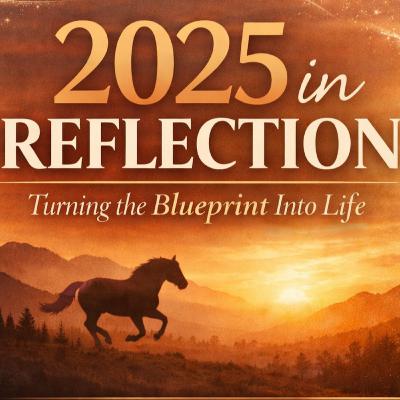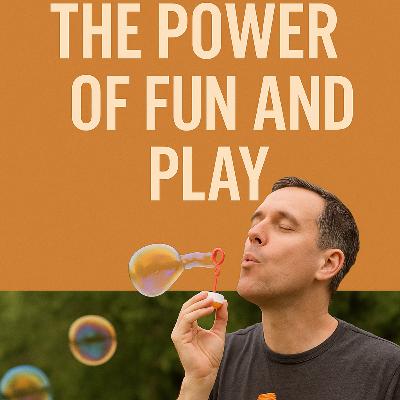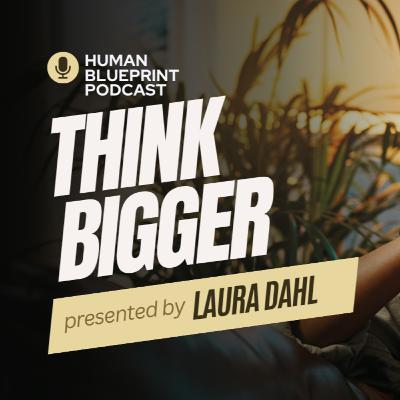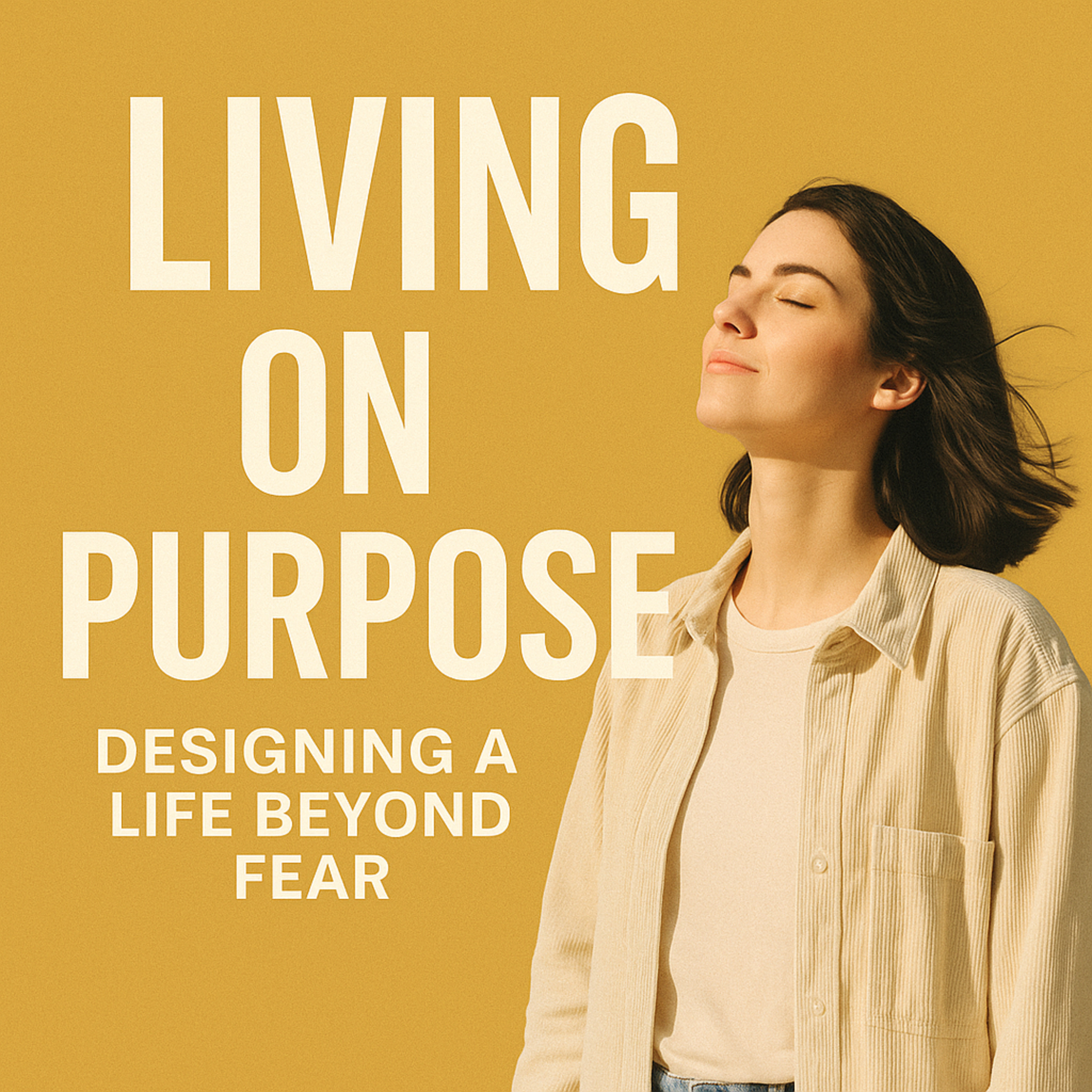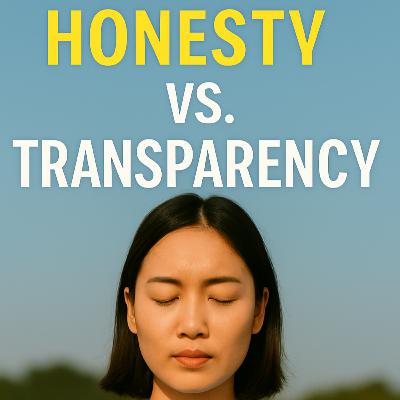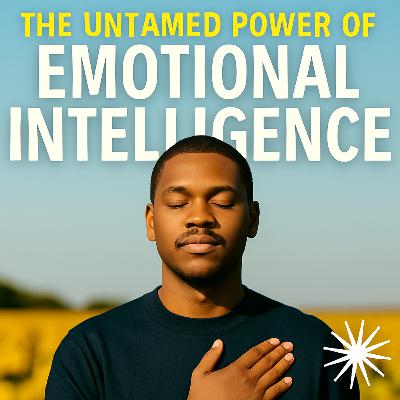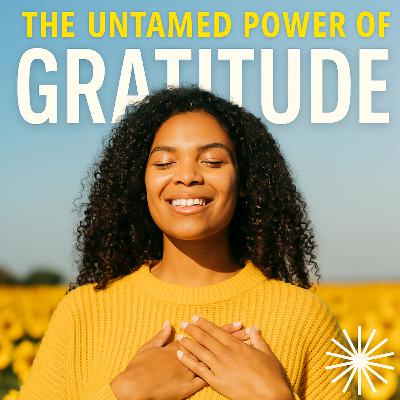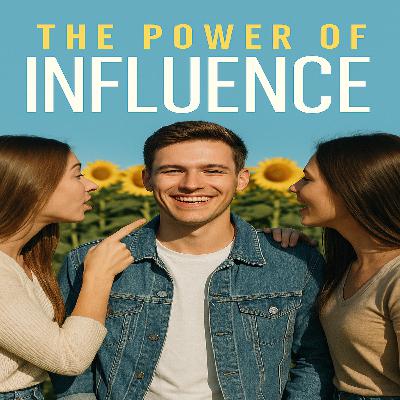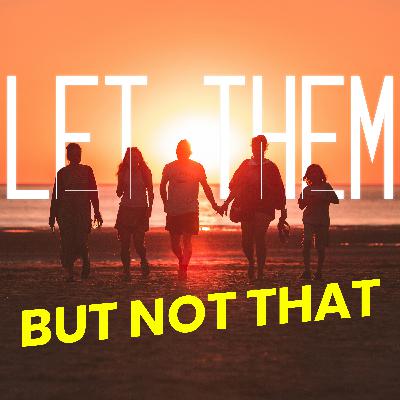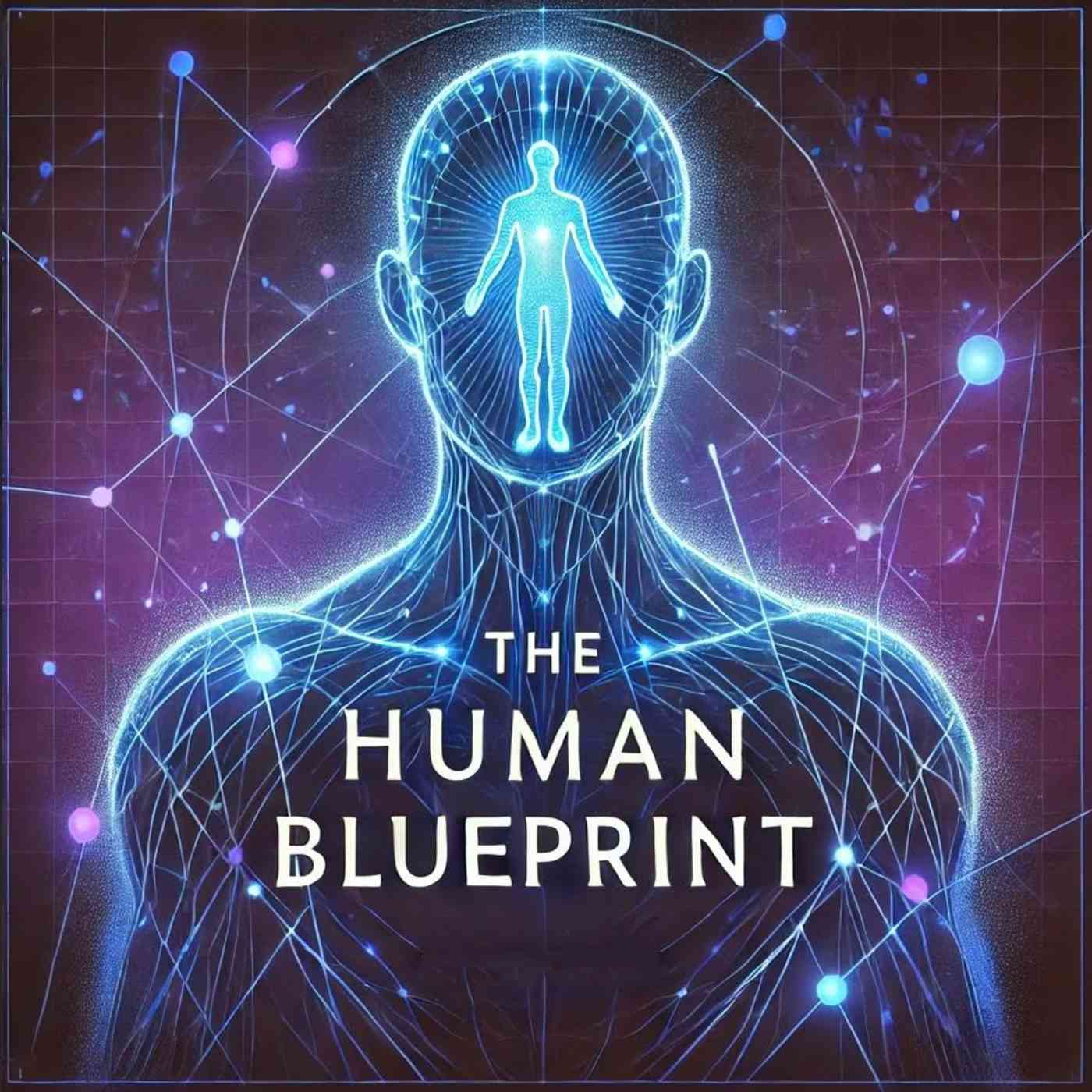Discover The Human Blueprint
The Human Blueprint

The Human Blueprint
Author: Laura Dahl
Subscribed: 127Played: 253Subscribe
Share
© Laura Dahl
Description
The Human Blueprint
Discover. Reflect. Transform.
Welcome to The Human Blueprint, a podcast that explores the raw, real, and relatable aspects of life. Through inspiring stories, actionable advice, and thought-provoking discussions, we dive deep into the challenges, triumphs, and transformations that make us human.
What to Expect
Topics That Matter: From personal growth and self-discovery to grief, relationships, confidence, and boundaries, we tackle the topics that shape our lives.
Engaging Stories: Each episode starts with a story or quote to draw you in and set the tone for meaningful exploration.
Practical Tools: Expect hands-on exercises, actionable advice, and guided reflections to help you apply the material to your own life.
A Lighthearted Tone: Serious topics, but with plenty of humor and relatable anecdotes to keep it engaging and real.
More Than a Podcast: Accompanying the podcast is a book and workbook filled with exercises and activities to deepen your journey of self-discovery and growth.
This podcast is for anyone ready to reflect on their life, overcome limiting beliefs, and take action to create a more fulfilling, authentic version of themselves. Whether you’re navigating grief, setting boundaries, or just trying to figure out who you are unencumbered, this is the space for you.
New episodes drop every Friday. Let’s discover, reflect, and transform—together.
#TheHumanBlueprint #PersonalGrowth #SelfDiscovery
Discover. Reflect. Transform.
Welcome to The Human Blueprint, a podcast that explores the raw, real, and relatable aspects of life. Through inspiring stories, actionable advice, and thought-provoking discussions, we dive deep into the challenges, triumphs, and transformations that make us human.
What to Expect
Topics That Matter: From personal growth and self-discovery to grief, relationships, confidence, and boundaries, we tackle the topics that shape our lives.
Engaging Stories: Each episode starts with a story or quote to draw you in and set the tone for meaningful exploration.
Practical Tools: Expect hands-on exercises, actionable advice, and guided reflections to help you apply the material to your own life.
A Lighthearted Tone: Serious topics, but with plenty of humor and relatable anecdotes to keep it engaging and real.
More Than a Podcast: Accompanying the podcast is a book and workbook filled with exercises and activities to deepen your journey of self-discovery and growth.
This podcast is for anyone ready to reflect on their life, overcome limiting beliefs, and take action to create a more fulfilling, authentic version of themselves. Whether you’re navigating grief, setting boundaries, or just trying to figure out who you are unencumbered, this is the space for you.
New episodes drop every Friday. Let’s discover, reflect, and transform—together.
#TheHumanBlueprint #PersonalGrowth #SelfDiscovery
21 Episodes
Reverse
2025 in Reflection: Turning the Blueprint Into LifeAs we close out the year, this episode is an invitation to pause — not to measure what you accomplished, but to honor what you released, learned, and became.In this year-end reflection, Laura looks back at the themes we explored together throughout 2025: inner leadership, boundaries, emotional maturity, capacity, resilience, joy, and what it truly means to live with intention. These conversations weren’t about fixing yourself — they were about coming home to yourself.We also talk about the symbolic transition from the Year of the Snake — a year of shedding, truth, and recalibration — into the Year of the Horse, a season of aligned momentum, forward movement, and intentional action. Not hustle. Not pressure. But movement that feels grounded and sustainable.In this episode, you’ll hear:A recap of the core themes and lessons from this year’s episodesGentle reminders to carry with you into the new yearHow to think about momentum without burning yourself outA preview of what’s coming next for The Human Blueprint: deeper content, a new mobile app, a supportive community, and four transformational retreats designed for women just like youThis episode is part reflection, part orientation, and part encouragement — a reminder that you don’t have to rush into what’s next. You’re allowed to move forward with clarity, compassion, and self-trust.If you’ve been listening all year, thank you for walking this path with me. And if you’re new here, welcome — you’re exactly where you’re meant to be.✨ Here’s to creating a life that actually feels like yours in 2026.Here is the link to the workbook pages: https://drive.google.com/file/d/1IpT79LwTrKA1e6httZFeNLecCabDSQM1/view?usp=sharing
When was the last time you had fun—real, unapologetic, can’t-stop-smiling fun?In this episode of The Human Blueprint Podcast, Laura dives into a moment that stopped her in her tracks: someone circling the word FUN during an exercise about what we need most in our lives right now. That simple choice sparked a powerful realization about how many adults—especially the responsible ones, the achievers, the caregivers, the “strong ones”—have forgotten how to play.This episode explores:✨ Why fun feels uncomfortable for so many adults✨ How high achievers accidentally shut down joy✨ The brain science behind play (and why your nervous system needs it)✨ What fun can look like for serious people✨ How reconnecting with play brings you back to your inner child✨ The truth about guilt, rest, and giving yourself permission to softenLaura also introduces the 30-Day Play & Joy Challenge, packed with simple, playful prompts that help you rebuild your joy muscle one day at a time.If you’ve been feeling burned out, disconnected, too serious, or stuck in survival mode… this episode is your permission slip to laugh, explore, create, and let joy back in.Because you weren’t born just to work and push through.You were born to live, feel, and play.Download the workbook and Fun Challenge here: https://drive.google.com/drive/folders/1uNRvZLqzamip3qxp1UznL1l5V2x0u-P0?usp=sharing
In this episode of The Human Blueprint, Laura Dahl steps behind the curtain to share a side of her expertise you don’t often hear on the show — the business of real estate and the power of thinking bigger. If you hold a real estate license (or dream of getting one), this episode will show you how that single license can unlock time freedom, location freedom, and money freedom.Laura dives into all the ways agents can earn income — from traditional residential and commercial sales to investing, development, property management, and creative side hustles. She shares how joining a company like Epique Realty at its infancy offers rare opportunities for ownership, stock, global growth, and passive income.Discover how to use the tools and systems Epique provides to multiply your income, automate your business, and build a true future nest egg — all while keeping your brand and identity intact.💡 Learn how to:Create multiple income streams with one licenseLeverage automation and AI tools to save time and scaleBuild passive income through recruiting and referralsMaintain your boutique brand while gaining corporate supportAchieve freedom — of time, money, and location — on your terms🎯 If you’re ready to think bigger and build a business that creates lasting freedom, visit lauradahl.epiquerealty.com/join to learn more.
Love, family, faith, community — the ingredients of an ordinary life that’s anything but ordinary.In this episode, Laura Dahl invites listeners into a deeply personal reflection on what it means to be seen, loved, and accepted for who you are. Through honest storytelling, humor, and vulnerability, she reminds us that LGBTQ+ families live parallel lives within the same communities — raising kids, volunteering, supporting the arts, donating to charities, and showing up for their neighbors.This episode is a call to empathy, understanding, and connection. Because at the end of the day, we’re all just trying to live, love, and belong.Quote highlight:“We live among you — in your neighborhoods, your schools, your churches.Different journeys. Same heartbeat. Because we’re not that different after all.”✨ Reflect deeper with the companion workbook:👉 Download The Human Blueprint Workbook🎧 Listen now on The Human Blueprint with Laura Dahl.
Finding Light in Heavy TimesThe world feels heavy right now. Division, tragedy, and the constant stream of news and online debates can leave us drained, anxious, and disconnected from the things that matter most. In this episode of The Human Blueprint, we take a much-needed pause to reset, unplug, and rediscover the simple joys that bring balance and peace.We’ll explore:How constant exposure to negativity impacts our mental healthPractical ways to set boundaries with social media and newsEveryday joys that anchor us in the middle of uncertaintyRefocusing on what we can control versus what we cannotHow to create healing conversations in divided timesSimple grounding exercises, journal prompts, and reset tools you can use right awayThis isn’t about ignoring the world—it’s about finding ways to care for yourself so you can show up with compassion and clarity, even when things feel overwhelming.Take a deep breath with me in this episode, and let’s reclaim some peace, joy, and perspective together.📥 Download the free companion workbook for this episode here: https://drive.google.com/file/d/1awwpBBbAq62tloWmy2LXYu5hosmdmNx9/view?usp=sharing
What happens when kids become the parents?In this episode of The Human Blueprint Podcast, Laura Dahl explores parentification—a hidden role reversal that can shape childhood and echo into adulthood. If you grew up feeling responsible for your parent’s emotions, carrying adult responsibilities too soon, or always being the “fixer,” this episode will resonate with you.The definition of parentification and the two main types: instrumental (practical responsibilities) and emotional (caretaking and support).Common signs a child is being parentified.The short- and long-term effects, from anxiety and lost childhood experiences to struggles with boundaries and people-pleasing in adulthood.How these patterns show up in adult relationships, careers, and daily life.Practical steps for breaking the cycle—including awareness, boundary-setting, and reclaiming your needs.Parentification isn’t about blame. It’s about awareness and healing. By naming it, you take the first step toward rewriting your story and reclaiming your right to be cared for.To support your journey, we’ve created a free companion workbook with a self-assessment quiz, reflection prompts, and practical exercises. Download it here:📕 Parentification Workbook (PDF)Parentification can build resilience, but it also leaves lasting emotional weight.Healing involves small daily practices: asking “What do I need today?”, practicing boundaries, and letting go of responsibilities that aren’t yours.You deserve care, rest, and support—just as much as anyone else.What You’ll Learn:Parentification can build resilience, but it also leaves lasting emotional weight.Healing involves small daily practices: asking “What do I need today?”, practicing boundaries, and letting go of responsibilities that aren’t yours.You deserve care, rest, and support—just as much as anyone else.If this episode resonates with you, please share it with a friend, subscribe to the podcast, and leave a review. Your support helps others find The Human Blueprint Podcast and begin their own journey of healing and growth.
Episode Theme:In a time when the world feels heavy—politics, health, racism, economic fear—it’s easy to slip intosurvival mode.But what if you could design your life instead of just reacting to it?This episode explores how to shift from fear-based living to value-driven intention.It’s about taking back your power.One small choice at a time.Core Message:Fear is loud, but it’s not always right.It can trick you into shrinking.It can keep you frozen, small, or constantly bracing for the next blow.Intention, on the other hand, is steady.It’s quiet—but deeply powerful.It reconnects you with your why, your worth, and your wants.You don’t need the world to calm down for you to live fully.You need clarity. You need courage. You need intention.What You’ll Learn in This Episode:● How fear subtly shapes your daily decisions● What intentional living really looks like (with examples)● Simple tools to help you design your week instead of defaulting to chaos● A full list of value-based intentions to guide your choices● How to make aligned decisions, even when the world feels uncertainFear-Based vs. Intention-Based Living:Fear-Based Living:● Saying yes when you mean no● Staying in relationships, jobs, or patterns because they feel “safe”● Avoiding discomfort at all costs● Consuming media that feeds anxiety● Choosing security over fulfillmentIntention-Based Living:● Asking yourself, “What matters to me today?”● Choosing peace over urgency● Saying the hard thing because honesty matters● Trying the new thing because growth matters● Protecting your energy because your health mattersHow to Start Living with Intention:● Morning Check-In:Ask: “What do I want to feel today?” or “What do I want to stand for today?”● Pick One Value:Anchor your day to it. If it’s honesty, have that tough conversation. If it’s joy, say yes tosomething fun.● Interrupt the Fear Loop:○ Turn off breaking news notifications○ Unfollow energy-draining accounts○ Limit comparison○ Reclaim your attention span● Bookend Your Day:○ Morning: Choose your intention○ Evening: Reflect on how your actions aligned with it️Menu of Value-Based Intentions to Choose From:Use this list daily, weekly, or whenever you need to reset.🎯 Clarity + Growth● Curiosity● Focus● Progress● Boldness● Learning● Vision● Growth❤️ Connection + Compassion● Kindness● Honesty● Presence● Empathy● Love● Support● Community🧘 Calm + Grounding● Peace● Simplicity● Slowness● Rest● Mindfulness● Ease● Trust💪 Courage + Strength● Bravery● Integrity● Strength● Truth● Conviction● Resilience● Confidence🌟 Purpose + Fulfillment● Joy● Creativity● Freedom● Abundance● Adventure● Contribution● GratitudePro Tip: You don’t need to do more. You need to choose better.Let your intention lead.Reflection Questions:● Where in your life are you reacting instead of choosing?● What’s one decision you’re making out of fear?● What value do you want to lead with this week?● What does intentional living look like for you right now?● What’s one small action that reflects the life you actually want?Calls to Action:● Try This: Choose one intention for the next 7 days. Let it guide your choices. Share it with ususing #TheHumanBlueprintIntentions● Download: Grab our free “Intentional Week Starter” worksheet to make this real in your life● Connect: Share this episode with someone feeling overwhelmed● Support the Show: Leave a 5-star review and tell us how you’re living on purposeResources: https://drive.google.com/drive/folders/1Up_zFh6hP5cDXhurgn02RbMrBwpPogUs?usp=sharing
You can be honest and still hide. But you can’t be transparent without being seen.In this episode of The Human Blueprint, we dive into the real difference between honesty and transparency—and why most of us are only scratching the surface.We’ll explore:How honesty and transparency show up differently in real lifeWhy we often avoid transparency (hint: fear of judgment, loss of control, vulnerability)What transparency looks like in work, relationships, parenting, and your personal evolutionHow to start being seen without losing your powerThis isn’t about oversharing—it’s about living and leading without the mask.🔗 Get the free workbook to go deeper: https://drive.google.com/file/d/1iX_IQ9kG0O0BpB9rjYcNe_Zjv_u8By-S/view?usp=sharingLet’s ask the real questions:Where are you being honest but not transparent?What do you think you’re protecting?And what might happen if you just said the truth out loud?If you loved this episode, share it with someone who’s ready to drop the performance and live unfiltered.
Emotional intelligence (EQ) is the skill that shapes how you handle stress, make decisions, and build relationships. In this episode, we explore what EQ really is, why it often matters more than IQ, and how you can strengthen it to improve your life. You’ll learn the 5 key components of EQ, how to recognize emotional triggers, and practical tips to respond (not react), communicate better, and lead with empathy.🎧 Listen now: The Human Blueprint Podcast📥 Get the free EQ Workbook: Download Here
“The Untamed Power of Gratitude” Workbook🌿 Section 1: Exploring Your Relationship With GratitudeReflection QuestionsWrite honestly. There are no right or wrong answers.When you hear the word “gratitude,” what feelings or thoughts come up?Do you ever feel pressure to be grateful, even when things are hard? When?Who taught you about gratitude—directly or indirectly?How has gratitude shown up during the darkest or most difficult times in your life?“Gratitude is not a bypass. It’s a reclamation.”Prompt:Write about a time when you chose to be grateful in a situation others might have seen only as loss or pain.What did that choice shift in you?What were you grateful for and in spite of?Gratitude doesn’t erase grief—it lives alongside it.Journaling ExerciseWhat is something (or someone) you’ve lost recently or are still grieving?Without dismissing the pain, can you find anything you’re still grateful for within that experience?Who is someone you deeply appreciate, but maybe haven’t told in a while?What would you say to them if you were being completely open and specific?Optional Exercise:Write them a letter (you don’t have to send it… but you can).List ExerciseList 3 things you’re grateful for right now, in this moment.List 3 things you’re grateful for that haven’t happened yet.This blends current joy with future hope.🔥 Section 2: Gratitude as Rebellion🤍 Section 3: Grateful and Grieving🤝 Section 4: Gratitude as Connection🌱 Section 5: What’s Present, What’s PossibleLink to Workbook: https://drive.google.com/file/d/13O6t9feXGQZ7QqROkMOQnJ_7Ng-N7sya/view?usp=drive_link
What is Influence?Influence is the ability to affect someone’s thoughts, feelings, or actions.It’s not about controlling others.It’s about inspiring them to take action or trust your guidance.Why Influence Matters in Real EstateBuyers and sellers rely on your expertise to make big financial decisions.They are looking for someone they feel confident following.Influence builds trust faster than facts alone.Example:Two agents give the same market report.The agent who confidently recommends a clear path forward earns the listing.How Realtors Use Influence DailyDuring Consultations: Guiding clients toward realistic expectations.Pricing a Home: Helping sellers understand market value vs emotional value.Negotiations: Persuading the other side to accept terms favorable to your client.Referrals: Influencing people to recommend you to others.Social Media: Building a brand people want to engage with.Positive vs Negative InfluencePositive = Empowering, Educating, Building TrustNegative = Manipulation, Fear Tactics, PressureExample of Positive Influence:Helping a first-time buyer feel confident buying despite fear.Example of Negative Influence:Pushing a buyer into a home they don’t love just to close a sale.How to Strengthen Your InfluenceBe Authentic. People can spot fake energy fast.Be Consistent. Stay active where your audience sees you often.Educate First. People follow those who teach them, not those who sell to them.Show Proof. Share client wins, testimonials, and success stories.Listen More Than You Talk. Understand their real needs before advising.Thought-Provoking Questions for Group DiscussionWhen have you been positively influenced by someone in business? What stood out?Have you ever been negatively influenced? What did you learn from it?How can you shift from “selling” to “guiding” more in your client conversations?What small change could you make this week to increase your influence?
Finding Motivation When You Don’t Feel MotivatedWelcome to the Human Blueprint Podcast.A podcast exploring the framework of personal growth, self-discovery, and resilience.Through relatable stories, humor, and actionable advice, we tackle life’s challenges tohelp you build a life of courage,confidence, and connection.I’m your host, Laura Dahl.Episode Overview:● Everyone struggles with motivation at some point—this is normal● Motivation doesn’t always come first—action often sparks it● Today, we’ll break down how to manufacture motivation when you don’t feel like doing anything● Practical strategies to push through when you’re feeling stuck1. Introduction (3-5 min)● Welcome listeners and introduce the topic● Acknowledge that motivation is fleeting—it’s unrealistic to expect to feel motivated all the time● Personal anecdote: Share a time when you personally lacked motivation but had to pushthrough anyway (e.g., launching a big project, exercising, writing a book, or even just getting outof bed some days)● Tease upcoming strategies:○ “Today, I’ll share how to create motivation when you don’t have any, the science behindgetting started, and practical tips you can implement right away.”Engagement Question: When was the last time you felt unmotivated? How did you handle it? Dropme a message or comment—I’d love to hear!2. Understanding Motivation (5-7 min)The Myth of Constant Motivation● Many people believe that successful or productive people are always motivated—this is false● Motivation is a feeling, and feelings fluctuate● Example: A professional athlete doesn’t wake up every day feeling excited to train, but they doit anyway because they rely on systems, habits, and disciplineIntrinsic vs. Extrinsic Motivation● Intrinsic Motivation: Driven by personal satisfaction or growth○ Example: Writing a book because you love storytelling○ Example: Running because it makes you feel mentally clear● Extrinsic Motivation: Driven by rewards, recognition, or consequences○ Example: Meeting a work deadline because your paycheck depends on it○ Example: Cleaning the house because guests are coming overKey Takeaway: You don’t have to wait for motivation—sometimes external factors can be the spark toget started.3. How to Manufacture Motivation (10-15 min)A. Take Action First—Action Creates Motivation● Motivation often follows action, not the other way around● Example: Instead of waiting to feel like working out, put on your workout shoes and commit tojust 5 minutes—most of the time, you’ll keep going● Psychological concept: The Zeigarnik Effect—our brains don’t like unfinished tasks, so oncewe start something, we feel compelled to finish itB. Reduce the Activation Energy—Make It Easy to Start● Lower the barrier to entry so the first step is easy● Examples:○ Want to start reading more? Keep a book by your bed, open to the page you left off○ Want to eat healthier? Prep snacks ahead of time so you’re not tempted by junk food○ Want to write every morning? Have your laptop open with a blank doc ready the nightbeforeC. Habit Stacking—Attach New Actions to Existing Habits● Developed by James Clear in Atomic Habits● Pair a new habit with something you already do consistently● Examples:○ After I make my morning coffee, I will journal for 2 minutes○ After I brush my teeth at night, I will do 10 squats○ After I check my email, I will send one outreach messageD. The 2-Minute Rule—Start Small to Avoid Overwhelm● Break down big goals into tiny, manageable steps● If something feels overwhelming, shrink it● Examples:○ Instead of “I need to clean the house,” start with “I’ll wipe down one counter”○ Instead of “I need to write a chapter,” start with “I’ll write one sentence”○ Instead of “I need to work out,” start with “I’ll stretch for two minutes”Why it works: Once you start, your brain shifts from “I have to” to “I’m already doing this.”E. The Power of Accountability & Environment● Your surroundings influence your motivation more than you think● Examples of environment hacks:○ If you want to eat better, remove junk food from your home○ If you want to read more, surround yourself with books○ If you want to work out, lay out your gym clothes the night before● Examples of accountability hacks:○ Tell a friend your goal and ask them to check in○ Join a group (online or in-person) with like-minded people○ Commit publicly (post on social media that you’re starting something)4. Overcoming Common Motivation Blocks (8-10 min)A. Procrastination & Perfectionism● Many people don’t start because they think they need to do it perfectly● Example: You don’t need the perfect gym outfit or the best equipment—just start moving● Strategy: The 15-minute rule—set a timer and commit to doing something for 15 minutes.Often, you’ll keep goingB. Burnout & Exhaustion● Sometimes a lack of motivation is actually a sign that you need rest● Example: If you’re drained, motivation won’t come—schedule intentional recovery time● Strategy: Try the 80/20 rule—focus on the tasks that bring the most results rather than trying todo everythingC. Fear of Failure● Fear keeps many people from even starting● Example: If you’re afraid to launch a business, write down the worst-case scenario—often, it’snot as bad as your mind makes it seem● Strategy: Reframe failure as data—each failure teaches you something, and every attemptbrings you closer to success5. Practical Takeaways & Challenges (5-7 min)● Recap the key points:○ Motivation isn’t something you wait for—it’s something you create○ Start small, take action first, and lower the barrier to entry○ Use habit stacking and accountability to stay on track○ Address common blocks like procrastination, burnout, and fearChallenge for Listeners:● Pick one strategy from today’s episode and commit to trying it for the next week● Example prompts:○ Set a 15-minute timer for a task you’ve been putting off○ Try habit stacking—attach a new habit to an existing one○ Reduce activation energy—make it easier to startEngagement:● “Let me know what worked for you! Tag me on Instagram or send me a message—I’d love tohear your experience.”6. Closing (3-5 min)● Thank listeners for tuning in● Next week’s episode teaser: Give a hint about the next topic● Call to action:○ If you enjoyed this episode, subscribe, leave a review, and share it with a friend○ Encourage engagement: “What helps you find motivation when you’re feeling stuck?Message me—I’d love to feature your ideas in a future episode.”
What if ADHD isn’t a deficit—but a set of hidden strengths?In this episode of The Human Blueprint, we reframe ADHD as a superpower. Laura shares personal stories and practical tools to help you stop fighting your brain and start using it to your advantage.You'll learn how to:Recognize traits like hyperfocus, creativity, and adaptability as assetsTurn distraction into curiosity and impulsivity into bold actionBuild systems that work with your brain, not against itUse strategies like body doubling, gamifying tasks, and energy sprints to stay productivePractice self-compassion while embracing your own rhythmThis episode is for:Adults with ADHD ready to harness their strengthsSupporters of someone with ADHDCreatives, entrepreneurs, and professionals wired differentlyADHD isn’t a flaw. It’s a different operating system. And once you understand how it works, it can change everything.Workbook and accompanying exercises can be found here: https://drive.google.com/file/d/1NHoSTwKKYcIgTJ_NF1r6TfbOoY34FjRC/view?usp=sharing
Mel Robbins’ Let Them philosophy is powerful but does it apply to everything? In this episode of The Human Blueprint Podcast, I dive into the distinction between letting go and setting boundaries. While we can’t control others, we also don’t have to tolerate disrespect, toxicity, or negativity.I’m done with keyboard warriors, polarizing rhetoric, and the culture of unchecked nastiness. In this episode, i’ll break down: When “letting them” brings peace vs. when it enables harmThe importance of boundaries in real life and onlineHow to push back against toxicity while protecting your energyLet’s talk about what we should and shouldn’t tolerate. Where do you need to draw the line? Drop a comment and let’s discuss!Don’t forget to like, subscribe, and share if this episode resonates with you!
Friendships are more than just social connections. They are essential to our well-being, happiness, and personal growth. In this episode of The Human Blueprint Podcast, we dive into the different types of friendships we all need in our lives, from the Cheerleader who lifts you up to the Truth-Teller who keeps you grounded.We’ll explore how to identify the roles your friends play, the importance of nurturing meaningful relationships, and how to let go of those that no longer serve you. Plus, discover practical tips to build stronger, healthier connections and reflection prompts to evaluate your current friendships.What You’ll Learn in This Episode:1. The six types of friendships and the unique roles they play in your life.2. Why friendships are vital to your emotional and mental well-being.3. How to strengthen your friendships through intentionality and communication.4. When it’s time to let go of toxic or unfulfilling relationships.5. Practical steps to create the friendships you’ve always wanted.Reflection Questions:What kind of friend are you to others?Are there gaps in your circle of friends?Which friendships bring you the most joy, and how can you nurture them?Free Resource: Download the Friendship Reflection Workbook for exercises, prompts, and actionable steps to evaluate and enhance your friendships: (https://docs.google.com/document/d/1iaBQ-KhtxjpBc26YkqKq4PQzoDX_zRSDRPSEdFM7AjM/edit)
What does it mean to truly be independent and self-reliant? In this episode of The Human Blueprint Podcast, we explore the power of independence and how to cultivate self-reliance in every aspect of life. From trusting yourself to overcoming common barriers like fear and self-doubt, this episode is packed with actionable advice to help you stand strong on your own two feet.What You’ll Learn in This Episode: 1. What independence and self-reliance really mean and how they apply to your life. 2. Why trusting yourself is key to confidence, fulfillment, and personal growth. 3. Common barriers to independence and how to overcome them. 4. Practical steps to develop independence and take ownership of your choices. 5. Real-life examples of independence in relationships, finances, work, and emotional well-being.💡 Reflection Questions: • What does independence mean to you? • Where do you feel overly dependent, and how can you shift toward self-reliance? • What fears or beliefs are holding you back from taking ownership of your life?📥 Download the Independence and Self-Reliance Workbook: https://drive.google.com/file/d/1gj3w0jC_XD5w4seSrIFqQ1fe9dQsUscZ/view?usp=drivesdkStart building your strength from within today!
Boundaries are the foundation of healthy relationships, self-care, and personal well-being. But during the holiday season, family dynamics, social pressures, and overcommitments can push boundaries to their limits. In this episode, we explore why boundaries are essential, the types of boundaries people often struggle with, and how to hold your ground with kindness and confidence.Learn how to protect your time, energy, and peace this holiday season—and all year long.What You’ll Learn in This Episode:• Why boundaries are a necessary form of self-care.• The different types of boundaries (time, emotional, financial, and more) and how they show up in daily life.• Common ways boundaries are violated and how to respond.• Practical strategies to set, communicate, and hold boundaries without guilt.• How boundaries can transform relationships and reduce stress.
How often do you pause to evaluate if your actions truly align with your values? This week on The Human Blueprint Podcast, I’m joined by Debbie Chamberlain, author of Stepping Stones: Stories of Finding Footing in Uncertain Times. Together, we explore the concept of personal integrity and how living in alignment with your core beliefs can transform your relationships, career, and confidence.🎙️ In this episode, we discuss: • What personal integrity is and why it’s essential for a fulfilling life. • How to identify and define your core values. • The challenges of staying true to your values in difficult times. • Actionable tips for aligning your daily decisions with your personal code of ethics.📥 Resources Mentioned: • Download the Personal Integrity Workbook: https://drive.google.com/file/d/1_0Fp2VY4Vgb9oPwTQNjXFnyiEXcIM1GI/view?usp=drivesdk • Learn more about Debbie Chamberlain (https://debbiegreerchamberlain.com/) and her book Stepping Stones: Stories of Finding Footing in Uncertain Times: https://a.co/d/eKHNuVV
Show Notes: Episode 3 – "Giving Yourself the Love You Deserve"Episode Title: Giving Yourself the Love You DeservePodcast Name: The Human BlueprintEpisode Summary:In this episode of The Human Blueprint, we explore the powerful concept of self-love and why it’s essential to your well-being. Learn how to treat yourself with the same kindness you extend to others, reframe negative self-talk, and prioritize self-care without guilt. This conversation dives into actionable strategies to build a healthier relationship with yourself and inspire confidence from within.Key Topics Covered:Why Self-Love MattersOvercoming societal pressures and self-criticism.Recognizing the importance of putting yourself first.Treating Yourself Like a FriendShifting your mindset to offer yourself the same compassion you give others.A simple reflection exercise to start practicing self-kindness.The Power of Positive Self-TalkRewriting the narrative in your head to build confidence and resilience.Practical tips and affirmations to replace negativity.Self-Care as a Necessity, Not a LuxuryRedefining self-care to include emotional, physical, and mental well-being.A list of self-care options you can try today.Building a Routine of Self-LoveStarting small with micro-habits for lasting change.Celebrating your wins along the way.Actionable Takeaways:Practice self-compassion by asking: What would I say to a friend in this situation?Write down three things you love about yourself each day for a week.Schedule one self-care activity for yourself this week—big or small.Resources & Links:Download the Self-Care Options PDFFollow us on Instagram for daily inspiration: @TheHumanBlueprintSubscribe to the podcast for more episodes like this!Connect With Us:Have thoughts or feedback about this episode? Share them with us on social media or send an email to hello@humanblueprintpod.com. We’d love to hear from you!Rate & Review:If you loved this episode, please leave a review and share it with a friend. Your support helps us reach more people who need these conversations.
Podcast Production Notes: Episode – "Who Are You Unencumbered?"Opening (2-3 minutes)Welcome listeners and introduce the theme of the episode: "Who are you unencumbered? If nothing held you back—fear, judgment, limitations—who could you be? What could you do?"Think about a moment when you felt truly unencumbered and how it impacted your sense of self.I want you to see this episode as an exploration of your potential and a guide to taking the first steps toward living unrestrained by fear or doubt.Segment 1: Small Actions Toward Unencumbered Living (10-15 minutes)Transition Statement: "Living unencumbered doesn’t require a complete life overhaul. It starts with small, intentional actions that align you with your true self."Set Daily IntentionsExample: Set a simple intention like being present, expressing gratitude, or prioritizing creativity and how it shaped your day.Actionable Advice: Try setting an intention each morning, such as “Today I will focus on finding joy in small moments.”Challenge Comfort ZonesPersonal Story: Talk about a time you stepped out of your comfort zone (e.g., trying a new skill, public speaking) and the unexpected rewards it brought.Examples:Try something you’ve always wanted to do but have avoided (like joining a class or hobby group).Speak up in a situation where you’d typically stay quiet.Carve Out Solo TimeSolo time is crucial for rediscovering who you are outside of roles and responsibilities.Personal Example: Reflect on a solo activity like hiking or a creative project and the clarity it gave you.Dedicate one afternoon a week to a solo experience that brings them joy or peace.Simplify Obligations“What’s one thing you can say ‘no’ to that doesn’t serve you?”Personal Story: Share how saying no to a commitment freed up time or energy for something that mattered more.Reflect on Wins and GrowthTalk about a recent moment when you acknowledged a small win—perhaps something as simple as trying a new recipe or completing a workout—and how it contributed to a sense of achievement.Keep a “Wins Journal” to track moments when you felt aligned with your true self.Practice Saying ‘Yes’ and ‘No’ AuthenticallyShare a moment when you said “yes” to something that excited you and “no” to something that drained you, and how it impacted your energy and focus.Practice this week by saying yes to something fun or inspiring and no to one unnecessary obligation."Each small action you take is like planting a seed for an unencumbered life. Next, we’ll talk about the importance of taking that first big step."Segment 2: Taking the First Step (15-20 minutes)Transition Statement: "Sometimes the hardest part of living unencumbered is taking the first step, but it’s also the most empowering."Create a ‘Dare-to-Dream’ ListShare your own “dare-to-dream” moment or and how breaking it into manageable steps made it achievable.Write down one bold dream and the smallest possible step to start pursuing it today.Ask Yourself a New Question Each MorningExamples of Powerful Questions:“What’s one small action I can take today to align with my true self?”“What would I do today if I weren’t afraid of failure?”Reflect on a moment when asking yourself the right question led to a breakthrough.Take One Risk Each WeekDiscuss the idea of starting with small risks to build confidence.Share a personal story of taking a calculated risk (e.g., reaching out to someone for advice or trying something new) and what it taught you.Take one small risk this week, like joining a community group, sharing a creative idea, or initiating a conversation.Do a 30-Day Challenge Focused on Your Unencumbered SelfExample: Share a challenge you’ve tried or would recommend (e.g., journaling every day, trying something new each week).Pick one area of growth or exploration and commit to it for 30 days.Practice Self-Compassion and Drop PerfectionDiscuss the importance of embracing imperfection as part of growth.Share an experience where “failing” taught you something valuable.Celebrate progress over perfection and recognize the courage it takes to try.Build a Vision Board or Affirmation ListTalk about the power of visualization and affirmations, sharing a personal success story or example of how this helped you or someone else.Spend 20 minutes creating a vision board or writing affirmations that reflect your unencumbered life.Schedule Reflection TimeDiscuss the importance of setting aside time to review progress and adjust goals.Block 15 minutes each week for reflection. Ask: “What worked? What didn’t? What can I try next?”"The first step might feel scary, but it’s the most important—and the most rewarding."Closing (3-5 minutes)Recap Key Points: Small actions and first steps build momentum. Living unencumbered starts with intentional choices and courageous beginnings.Call to Action: Take one specific action this week—write a dare-to-dream list, take a small risk, or set aside time for solo reflection.


